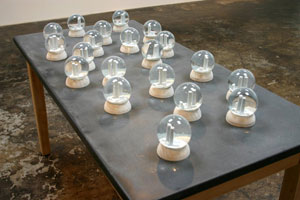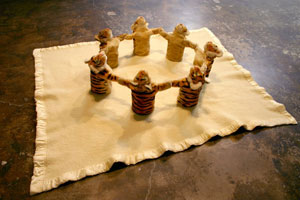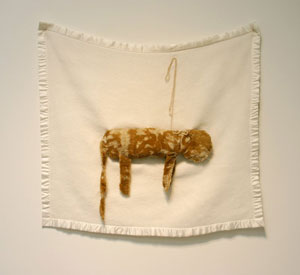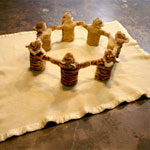Sometimes it is worth it to over-interpret a work of art. Finding meaning where there is little to none not only feels good, but is what art critics do well and art historians do best. Inflated judgment – art criticism of the blowhard bon vivant variety – is the ideological glue of art world society. No, a cigar isn’t always just a cigar. It is a many splendored thing: a phallus, hardened dreck or a chocolatier’s love child.
The work of Helen Altman provides the opportunity to see things that are not really there. Prima facie, it is soft, girly and suggestive of an edgy feminist politics. But ultimately it is only two of the above: pink, pretty but not punchy in the meaningful way one might wish.
Arbiters of form – that is, over-determiners – will want to read much more conceptual fancy into My Best Eggs. In this piece, nine old silverware boxes line the wall on a 16-foot shelf. Inside of them are mock eggs of different sizes and hues, laid out according to a legend attached to the inside lid. Quaint names, such as Abbey, Violet, Panama and Aunt Bea, follow in typescript accordingly. Though not exactly identical, the eggs are arranged the same way in each box, following the faint-lined picture key. The title, My Best Eggs , and each box’s passel of mottled and putty-colored eggs invite a more profound reading. This work perhaps is one woman’s take on the monotone ticking of her biological clock and the passing of her “best eggs” into the realm of rot and desuetude. Would that it were.
In Altman’s mind, this work is a paean to the passing of her favorite pets. In form, the piece offers a delicate take on the hard edges of 1950s Minimalism. Inside Altman’s serial square boxes, we do not find the reflective sheen of Donald Judd’s aluminum boxes or the fingery plastic of Eva Hesse’s Accession II. Rather, more akin to a baby’s cradle or to life on the farm, there is the soft fold and pleat of striped mattress ticking. A similar logic of accidental imbalance – great form coupled with a simple, cozy idea – attends Towers and Towers 1.5 . Each work is a display of snow globes on a table, 20 in one and six in the other. Striking, though, is what is inside the small spheres: the World Trade Center in miniature, cast in gray plastic. These are at once beautiful and ironic, lovely yet punk. The postcard for the show, a close-up of several globes with white confetti-snow astir, reveals the photogenic quality of the small round microcosms. Altman intelligently profits from the macabre memory attached to the towers. She claims that the globes were “not made in response to the September 11th attack, but made in response to seeing the twin towers in film and television several years afterward.” Altman boldly transgresses the boundaries of social propriety here, but in tiptoe fashion. It has been difficult since 9/11 to see the towers standing so nonchalantly in film footage made before the awful event, but Altman has transformed those feelings by shooting them through a scrim of commodified form. They may be works of art, a way to channel alienation from an event and its aftermath, but they also look like street-bought tchotchkes, so many souvenirs from a happy week spent in the Big Apple.
The moment of accidental imbalance lies in Altman’s claim that they “were not made in response to the September 11th attack.” It may be an argument of semantics, but it is an important one. These snow globes are in fact fundamentally about the attack on the World Trade Center and the manner in which, as a result, marauders, would-be pundits and so-called leaders of the free world have reified the event into a commodity for sale. In deploying such a loaded signifier, the World Trade Center, these cute round globes set off a whirlwind of unwitting declaratives, one of which quietly damns the manner in which some have profited politically off of the event.
Despite such accidental imbalance, there is a willful audacity in the oddity of certain work. Goldfish (4 bowls) , for example, offers a charming anomaly of ersatz form, with four goldfish bowls containing orange, bug-eyed epoxy-resin fish floating at a standstill inside cast-plastic faux water. Similar to that of the snow globes, tension arises from the clean quality of the work, which bestows upon the small fishbowls a kind of toy store-cum-Spencer’s Gifts quality. Altman remakes the readymade, transforming it into something that is almost but not quite personal.
The embroidered blanket and blanket-and-stuffed animal pieces, Who Am I, Circle of Friends and Dog’s Kitty, are at once cutesy and bizarre. Once again, this work dances along the fault line of something profound. The subtlest, not to mention weirdest, of the three is Dog’s Kitty, a tattered, eyeless, brown and white understuffed cat sewn to a droopy white blanket that hangs on the wall. A leash-like string attached to its neck extends without tautness across the fabric. Different from Circle of Friends, with its Henrietta Pussycat puppets arranged in a circle on a blanket sitting on the floor, the wall installation of Dog’s Kitty distances it ever so slightly from Mike Kelley’s work of the last 15 years. Though not so long ago we may have been wont to criticize such placements on the wall as tame, and so to fault Altman for not going far enough away from art house traditions, today a soiled gray-white blanket with a flaccid stuffed animal hung on the wall reads just right, like a well-timed nose-thumbing to a world where painting has returned in high-tuned, commodified form.
Images courtesy Dunn and Brown.
Charissa N. Terranova is an Associate Proffessor at SMU and a Contributing Editor to Glasstire.







